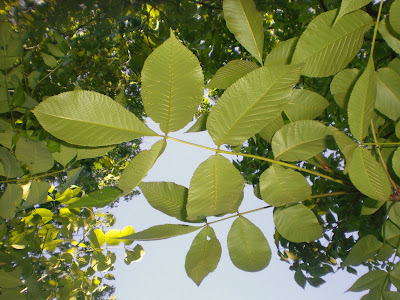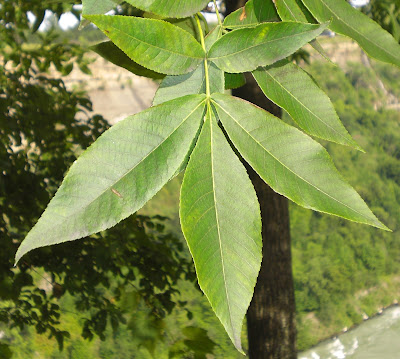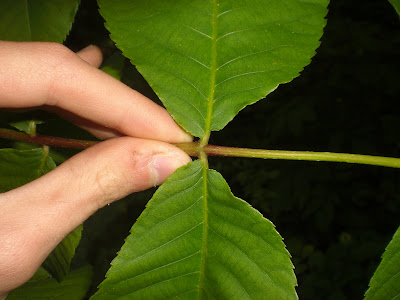This grand, incredibly illusive Hickory is very poorly understood. Many botanists regard this tree and the very similar Pignut Hickory (Carya glabra) as the same species, or treat it as a northern ecotype of the Pignut, known as a variation (Carya glabra var. Odorata). To add to the confusion, some sources state that the Red Hickory (whether distinct as a species or treated as a varation) is only found in the United States, and is therefore absent in Canada altogether. Describing the Red Hickory as rare and notoriously irregular is, however, appropriate.
I treat the Red Hickory as a distinct species, for I am yet to see any evidence, visually, of characteristic overlap between this tree and the Pignut Hickory. Due to the lack of up to date information and a general lack of interest put into finalizing this issue, all available sources vary considerably in their opinions. Upon finally seeing both trees in the wild, I have been able to draw my own conclusions, which are at least the current facts pertaining to it's geographical range here (one characteristic can be updated undoubtedly: this species IS found in Canada, this photo being testiment!)

Here are the leaves of Red Hickory. They usually have 7 broad, elliptical leaflets with smooth, hairless surfaces and paler, similarly smooth undersides. What emmediately sets this Hickory apart from the others is relatively simple. The Shagbark Hickory (Carya ovata) is MUCH more common, and usually has 5 leaflets instead of 7. The leaves can also be coarse in texture on the undersides, while Red Hickory leaves always remain smooth. The Bitternut Hickory (Carya cordiformis) can also have 7 leaflets, but it sometimes has 9 and the leaflets are considerably smaller than Red Hickory (notice the size of leaflets in the following photos) Pignut Hickory is another rare Hickory, but the leaflets are narrow rather than broad, and there are usually only 5 leaflets.

This is the leaf of a PIGNUT HICKORY. If you compare the two photos, it is very easy to differentiate these two 'apparently' very similar species. (Pignut = narrow, glossy leaflets with 5 leaflets and small basal pair vs. Red Hickory = broad, matte leaflets with 7 leaflets) I am yet to be convinced as to why so many botanists, taxonomists and the like appear to be so confused as to the genetic stability of these two trees when they obviously look different. The very limited literature discussing the Pignut and Red Hickory does not help me (and I am sure other amatures) to get even a clue as to really what could really be going on! Or maybe I am yet to run into one of these 'nomenclatural disaster' specimens of Red Hickory or Pignut Hickory which has intermittent qualities. We shall see!

This is the leaflet of the Red Hickory, very big! Note the tappering, wedge shaped base and the serrated edges. They are not very glossy, but still smooth to the touch!

Underside of the same leaflet. It is pale, but still smooth to the touch. In the vien axils and along the midrib there may be some small tufts of hair, but that is all.

This is a distinguishing feature for the Red Hickory. inbetween where the leaflets attach to the central stalk, there is a reddish blush that is absent on all other native Hickories. This is a subtle detail, but it is key!

This is a view of the twig. Here, you can notice that the bases of the leaf stalks are also blushed red, sometimes even light purple. This is an even more noticeable feature that is not nearly this dramatic, or completely absent all together, on other Hickories. Also note that the aborted buds on the twig are rounded and not sharp or pointed, this is characterisic!

The mature bark of the Red Hickory. The bark is very dark colored, and composed of flattened interlacing plates. The plates are not long and shaggy like those of the Shagbark Hickory, but are much blockier than the Pignut Hickory. This tree was found growing along the escarpment along the Bruce Trail near Borer's Falls. Red Hickory loves dry, upland soils, especially if they are limestone.
 Here are the leaves of Red Hickory. They usually have 7 broad, elliptical leaflets with smooth, hairless surfaces and paler, similarly smooth undersides. What emmediately sets this Hickory apart from the others is relatively simple. The Shagbark Hickory (Carya ovata) is MUCH more common, and usually has 5 leaflets instead of 7. The leaves can also be coarse in texture on the undersides, while Red Hickory leaves always remain smooth. The Bitternut Hickory (Carya cordiformis) can also have 7 leaflets, but it sometimes has 9 and the leaflets are considerably smaller than Red Hickory (notice the size of leaflets in the following photos) Pignut Hickory is another rare Hickory, but the leaflets are narrow rather than broad, and there are usually only 5 leaflets.
Here are the leaves of Red Hickory. They usually have 7 broad, elliptical leaflets with smooth, hairless surfaces and paler, similarly smooth undersides. What emmediately sets this Hickory apart from the others is relatively simple. The Shagbark Hickory (Carya ovata) is MUCH more common, and usually has 5 leaflets instead of 7. The leaves can also be coarse in texture on the undersides, while Red Hickory leaves always remain smooth. The Bitternut Hickory (Carya cordiformis) can also have 7 leaflets, but it sometimes has 9 and the leaflets are considerably smaller than Red Hickory (notice the size of leaflets in the following photos) Pignut Hickory is another rare Hickory, but the leaflets are narrow rather than broad, and there are usually only 5 leaflets.